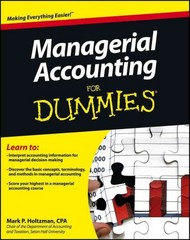Question
Question 3 (20 points) The following summarizes the balance sheet and income statement for a property-casualty insurer. Amounts are in millions of dollars. The firm's
Question 3 (20 points)
The following summarizes the balance sheet and income statement for a property-casualty insurer. Amounts are in millions of dollars.
The firm's income statement for 2017 reported the following numbers to which taxes have been allocated:
Income on underwriting activities, after-tax
353
Investment income and realized gains on investments, after-tax
891
In 2017, the expected return (after-tax) on the investment portfolio is 6%. Unrealized losses on available-for-sale investments of $124 million were reported as part of other comprehensive income.
(a)Calculate the residual income from underwriting activities for 2017. Use beginning-of-year balance sheet numbers in the calculation and a required return of 9%.
(b)Value the equity as of the end of fiscal 2017 under a forecast that the residual income from underwriting will grow at 2% per year in the future.
Question 4 (20 points)
A firm began its fiscal year with a book value of common equity of $823 million and net financial assets of $125 million. At the end of the year, it reported book value of common equity of $1,782 million and net financial assets of $156 million. Comprehensive income was $123.45 million for the year, with part of the income being interest from the beginning-of-year net financial assets earning at an after-tax rate of 1.2%.
(a)Calculate the return on common equity (ROCE) on beginning-of-period balances.
(b)What was the net payout to shareholders during the year?
(c)Cash dividends of $45 million were paid out to common shareholders during the year. There were no stock repurchases. What explains the remaining net payout shareholders and in what amount?
Question 5 (20 points)
In a financial report, Delta Airlines (DAL) reported book value of common equity of $0.048 (a negative book value) and $10,457 million in net financial obligations. The annual after-tax borrowing cost is 2.1%. The 846 million outstanding common shares trade at $9.62 each.
(a)Calculate the enterprise price-to-book ratio at which DAL trades.
(b)Analysts are forecasting forward earnings of $2.46 per share. Calculate the (enterprise) forward P/E ratio.
(c)Analysts are forecasting earnings-per-share growth over the next five years at an annual rate of 34.5%. With this forecast as a base, what is the PEG ratio?
Step by Step Solution
There are 3 Steps involved in it
Step: 1

Get Instant Access to Expert-Tailored Solutions
See step-by-step solutions with expert insights and AI powered tools for academic success
Step: 2

Step: 3

Ace Your Homework with AI
Get the answers you need in no time with our AI-driven, step-by-step assistance
Get Started


